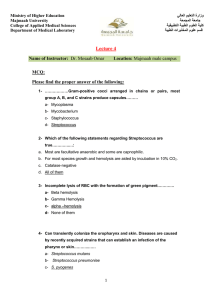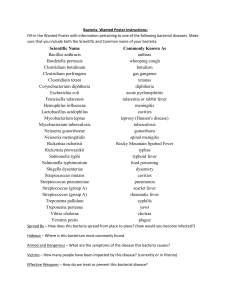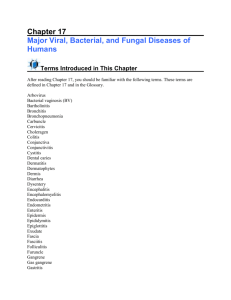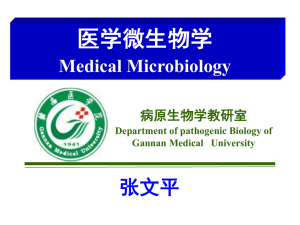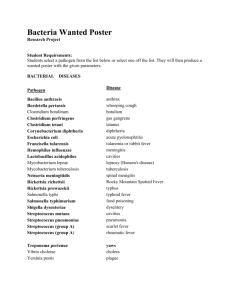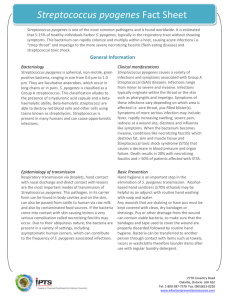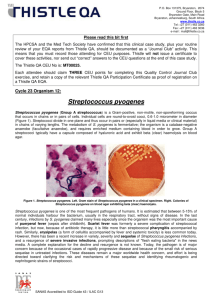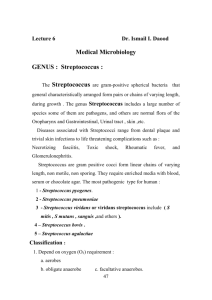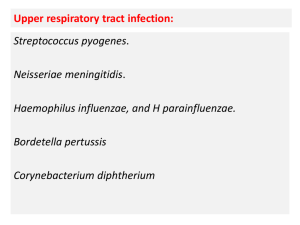Herpes Virus - MBBS Students Club
advertisement
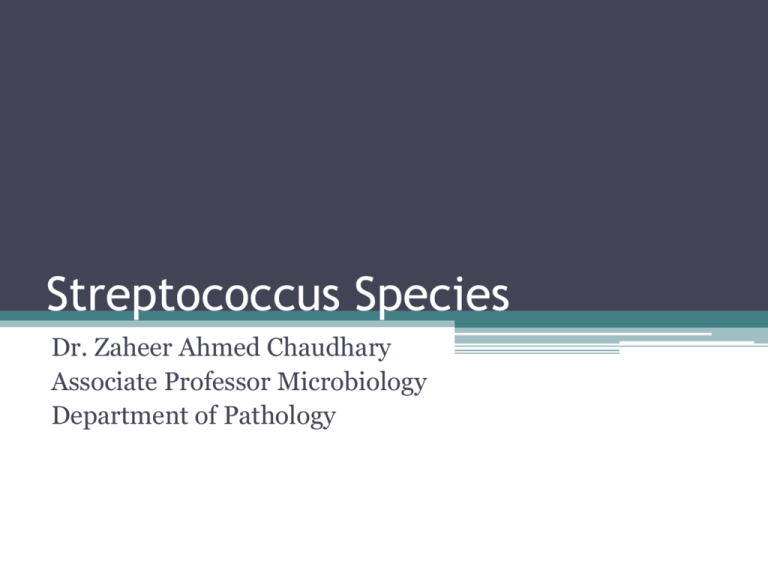
Streptococcus Species Dr. Zaheer Ahmed Chaudhary Associate Professor Microbiology Department of Pathology Introduction • • • • • • • • One of the two main human pathogens. Gram positive cocci. Oval shaped. Arranged in chains and pairs. Catalase negative. Non motile. Facultative anaerobe. Capsulated/ non capsulated. Catalase Test Classification • Based on : ▫ Serology: using Lancefields antibodies to cell wall carbohydrate. ▫ Hemolysin test. ▫ Biochemical tests. Serology • It is based on C carbohydrate present in the cell wall and its specificity is determined by an amino sugar. • Antibodies to carbohydrate are detected and classified into A to U. • There are more than 20 groups in Lancefield grouping. • All Lancefield groups are pyogenic in nature. Hemolysin test • There are three types of hemolysis on blood agar plate namely ▫ Alpha hemolysis: Green zone around the bacterial colony which is due to incomplete hemolysis of RBCs in the agar. ▫ Beta hemolysis: Clear zone of hemolysis around the bacterial colony of blood agar which is due to complete lysis of RBCs. It is produced by an enzyme hemolysin O & S. Beta streptococci have two antigens in their cell wall. 1. C-carbohydrate 2. M protein M protein : is an important virulence factor and determines the type of group A, B streptococcus. It is antiphagocytic in nature. Approximately 80 serotypes are present on the basis of M protein. Some strains produce rheumatic fever and some cause kidney infections. ▫ Gama Hemolysis: No hemolysis is produced on blood agar by the bacterial colonies. Beta-Haemolytic Colonies Biochemical Tests • Following tests are done to classify different bacteria on the basis of chemical reaction. ▫ CAMP Test – Streptococcus agalactae. ▫ Growth inhibition to the bacitracin disc– Streptococcus pyogenes. ▫ Sensitivity to optochin disc – Streptococcus Pneumoniae. ▫ Bile solubility test – Streptococcus faecalis. Bacitracin Sensitivity Streptococcus Pyogenes Medically important Streptococci • • • • • • Streptococcus Pyogenes – Group A Streptococcus agalactae – Group B Streptococcus faecalis – Group D Streptococcus bovis – Group D Streptococcus Pneumoniae Viridans group Streptococci Diseases caused by Streptococcus • Strept. Pyogenes (Group A): produces bacterial diseases like cellulitis, pharyngitis, impetigo, necrotizing skin lesions and streptococcal toxic shock syndrome. • Two immunogenic diseases i.e Rheumatic fever and glomerulonephritis are also caused. • Streptococcus agalactae (Group B) : is the leading cause of neonatal sepsis and menigitis. • Streptococcus faecalis (Group D): causes hospital acquired urinary tract infection (UTI) and endocarditis. • Streptococcus Pneumoniae: causes pneumonia in young children and low immunity adults. • Viridans group Streptococci & Streptococcus bovis : common cause of endocarditis. Beta Hemolytic Streptococci • Lancefield group A – U on the basis of antigenic differences in C- carbohydrates. • Group A : ▫ Streptococcus pyogenes is the most important human pathogen causing sore throat and skin infections. ▫ The organism adheres to the epithelium via pili covered by lipoteichoic acid and M proteins. ▫ Growth is inhibited by bacitracin disc. • Group B: ▫ Streptococcus agalactae colonizes in the genital tract of women, causes neonatal meningitis and sepsis. ▫ Resistant to bacitricin. • Group D : Comprises of Enterococci – Ent. faecalis, Ent. faecium Non enterococci - Strept. bovis ▫ They are normal flora of gut and can produce UTI, biliary and CVS infections. ▫ Hardy organisms and can grow in saline and bile. ▫ Non enterococci cause similar infections but the organisms are less hardy. • Group C , E, F, G, H, K-U : ▫ Cause human diseases infrequently. Transmission • Most Streptococci are part of the normal flora of skin, throat and intestine but produce diseases only when they gain entry to the blood circulation. • Viridance group and Strept. pneumonae are chiefly found in oropharaynx. • Strept. pyogenes is found on skin. • Strept agalactae is found in vagina and colon. Pathogenesis • Pyogenic inflammation. • Exotoxin production. • Immunogenic. Pyogenic Inflammation • M protein is the most important antiphagocytic factor. Group A produces 3 enzymes. ▫ Hyaluronidase : It degrades hyaluronic acid which forms ground substance of subcutaneous tissue. It is also known as spreading factor since it facilitates the spread of infection to the tissue. ▫ Streptokinase : It activates plasminogen to form plasmin which dissolves fibrin into clot, thrombi and emboli. It is used to lyse fibrin clots in coronary vessels in heart attack patients. ▫ DNAse : Degrades DNA in exudates or nectrotic tissues. ▫ Toxins: Various toxins are produced by streptococci. Erythogenic toxins : It causes rash of scarlet fever. It acts as a super antigen. Streptolysin O : It is hemolysin which is inactivated by oxidation and causes rheumatic fever. Streptolysin S : It is oxygen stable and is not activated by oxidation. Pyogenic exotoxin A : Causes toxic shock syndrome. Pyogenic exotoxin B : Rapidly destroys the tissue and causes necrotizing fasciatis. Clinical Finding • Group A causes pharangitis , sinusitis, mastoiditis, meningitis, TSS. It can also cause endometritis. • Group B causes neonatal sepsis, meningitis, pneumonia endocarditis and osteomylitis. • Group D causes UTI in hospitalized patients, indwelling catheters, pelvic infection. Complications • Immunogenic response to streptococci can result in two forms : ▫ Acute glomerulonephritis. ▫ Rheumatic fever. ▫ Acute glomerulonephritis: It occurs 2 to 3 weeks after the acute skin infection. Antigen-antibody complex gets deposited on glomerular basement membrane of the kidney leading to acute infection. This process can be stopped by avoiding colonization of skin by streptococcus group A. ▫ Acute Rheumatic fever: It occurs two weeks after pharangitis. It is characterized by fever, migratory polyarthritis and carditis. Mitral and aortic valves are involved. Prevalent in children between the age of 5-15 years. ▫ ASOT (Anti streptolysin O titer): ▫ Rheumatic fever is due to immunological reaction between cross reacting antibodies to M protein of streptococcus A with antigens of joints , hearth and brain. ▫ It can be prevented if treated within 8 days. Lab Investigations • • • • • Clinical presentation. Throat swab culture. CAMP test. Asculin test. Serological tests (ASOT). Treatment • Penicillin G or amoxicillin. • Erythromycin or Clindamycin in allergic patients. Prevention • Prompt treatment to group A streptococcal infections. • Preventive benzyl penicillin every month. • Use of amoxycillin preoperatively. • All pregnant women should be screened for Group B streptococcus by vaginal and rectal cultures at 37 weeks gestation. • Penicillin is administered at the time of delivery. • No vaccine. Introduction • Two types of streptococci which produce alpha hemolysis. ▫ Streptococcus pneumoniae ▫ Viridans Group Streptococcus Capsules of Pneumococci Streptococcus pneumoniae • Most common cause of community acquired pneumonia. • It produces following diseases namely bacteremia, meningitis, upper respiratory tract infection, otitis media, sinusitus, mastoiditis and conjuctivitis. General Characteristics • Gram positive, lancet shaped cocci in pairs or short chains. • Tend to be oval with pointed ends. • Thick capsule around the organism. • Produce alpha hemolysis. • Lysed by bile salts. • Growth is inhibited by optochin disc on blood agar. • • • • Capsule produces quellung reaction. Capsule acts as virulance factor. It interferes with phagocytosis. C-substance in the cell wall reacts with normal serum proteins made by liver called CRP. • It is increased in acute infection, 1000 folds and is used to monitor the progress of the disease. Transmission • 5-50% of normal healthy people harbor virulent organism in oropharynx. • It is not a communicable disease. • Disease incidence increases with predisposing factors which include : ▫ ▫ ▫ ▫ Alcohol or drug intoxication. Abnormality in the respiratory system. Pulmonary congestion. Splenectomy Pathogenesis • Pneumococci produces IgA protease which enhances the ability of the organism to colonize in upper respiratory tract. • It multiples inflammation. in the tissue and causes • Polysacchride capsule is the main virulence factor. • Lipoteichoic acid activates the complement and induces inflammatory cytokines production. Clinical findings • Sudden chills, fever, cough and pleuretic pain. • Sputum is red / brown color. • It is prominent cause of ear infection sinus, eyes, bronchioles and sepsis in immunocompromised patients. Lab Diagnosis • Gram smear - Lancet shaped Gram positive diplococci. • Smear Culture - Positive in 15-25% cases. Draughtsmen colonies on blood agar. • Quellung Reaction. • Bile soluble • Alpha hemolytic colonies on blood agar. • Growth inhibited by optochin. • CSF culture. Draughtsmen Colonies of Pneumococcus Optochin Disc Sensitivity Treatment • Penicillin G is the drug of choice. • Erythromycin. • Quinolone & vancomycin in resistant cases. Prevention • Mortality rate is high in elderly people, immunocompromised and debilitated persons. • Polysacchride vaccine (Polyvalent 23 type) is recommended. It has 5 years protection and needs booster dose after it. • Conjugated vaccine comprises of diphtheria toxoid with a carrier protein. It is given to young children. Viridans Group Streptococcus • Alpha hemolysis or no hemolysis on blood agar. • Produces green zone around the colony as a result of incomplete hemolysis of red cells. • Not bile soluble. • Growth not inhibited by optochin disc. • Viridans group comprises of the following : ▫ Streptococcus mitus ▫ Streptococcus sanguis ▫ Streptococcus mutans • Sanguis and mitis are the normal flora in the mouth and colon. They enter the blood stream after dental surgery. • Few strains can cause brain abscess in combination with mouth anaerobic organisms. • Mutans produce polysacchride in dental plaque leading to dental caries and peridontal abscess. Peptostreptococci • They are the members of the normal flora of the gut, mouth and female genital tract. They are anaerobic organsims. • They participate in mixed anaerobic infections e.g peptostreptococci and viridans streptococci both are members of normal flora but are found in brain abscess following dental surgery.
